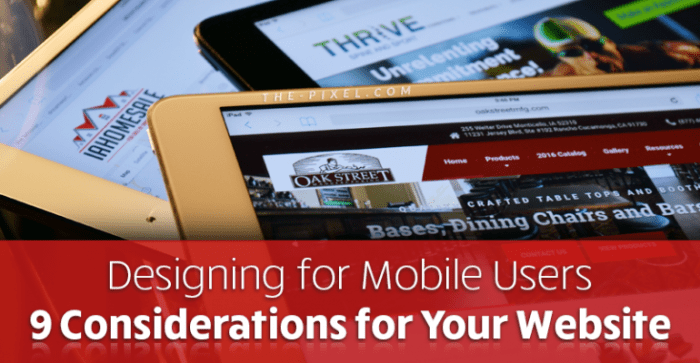Designing for Mobile Users takes center stage, inviting readers into a world of seamless digital experiences tailored for on-the-go interactions. Dive into the realm of mobile design where user preferences and behaviors shape the landscape of innovative interfaces.
Explore the nuances of mobile user behavior and responsive design principles that revolutionize the way we engage with digital content on our handheld devices. Get ready to discover the art of mobile navigation and its impact on enhancing user satisfaction and interaction.
Importance of Mobile Design

In today’s digital landscape, designing for mobile users is crucial due to the increasing use of smartphones and tablets. With more people accessing the internet on mobile devices, businesses and websites must prioritize mobile design to provide a seamless user experience.
Mobile design impacts user experience in significant ways. For example, a website that is not optimized for mobile devices may have slow loading times, difficult navigation, and poor readability. This can lead to frustrated users who are more likely to abandon the site and seek out a competitor with a more mobile-friendly interface.
Designing for mobile users differs from designing for desktop users in various aspects. Mobile design requires a more streamlined approach, with a focus on simplicity, easy navigation, and touch-friendly elements. On the other hand, desktop design allows for more complex layouts, detailed graphics, and hover effects that may not translate well to mobile devices. It’s essential to consider these differences and tailor the design to provide the best experience for users on each platform.
Mobile User Behavior: Designing For Mobile Users
Mobile users exhibit specific behaviors and preferences that impact their interaction with mobile interfaces. Unlike desktop users, they tend to have shorter attention spans and expect quick access to information. Understanding these behaviors is crucial for designing effective mobile experiences.
Touch Gestures
When designing for mobile users, it is essential to consider touch gestures such as tapping, swiping, pinching, and zooming. These gestures play a significant role in how users navigate through apps and websites on their mobile devices. Incorporating intuitive touch interactions can enhance the user experience and make it easier for users to engage with the content.
Screen Size Consideration
Another important factor to consider in mobile design is screen size. Mobile devices come in various sizes, from smartphones to tablets, which can impact how users interact with the interface. Designing for different screen sizes requires a responsive approach to ensure that the content is displayed optimally across devices. This adaptability is key to providing a seamless user experience regardless of the device being used.
Responsive Design Principles
Responsive design principles are crucial for creating a seamless experience for mobile users. By following key principles, designers can ensure that their websites or apps adapt to different screen sizes and devices.
Importance of Fluid Grids and Flexible Images
Using fluid grids and flexible images is essential in responsive mobile design. Fluid grids allow content to adjust proportionally based on the screen size, ensuring that the layout remains consistent and readable. Flexible images scale accordingly to prevent distortion or cropping, maintaining visual integrity across devices.
Mobile-First Design Concept, Designing for Mobile Users
Mobile-first design is a strategy where the initial focus is on designing for mobile devices before scaling up to larger screens. This approach prioritizes the mobile user experience, leading to faster load times, better performance, and a more user-friendly interface. By starting with mobile design, designers can ensure that the core content and functionality are optimized for smaller screens, enhancing overall usability.
Mobile Navigation Best Practices

When designing for mobile users, it is crucial to consider the navigation experience as it directly impacts how users interact with your website or app. Here are some best practices to optimize mobile navigation:
Effective Mobile Navigation Patterns
- Use a hamburger menu: The three horizontal lines icon is widely recognized as a menu symbol on mobile devices, providing a familiar and compact way to access navigation options.
- Thumb-friendly navigation: Place important menu items within easy reach of a user’s thumb to enhance usability and reduce strain.
- Clear labels: Ensure menu labels are concise, descriptive, and easy to read to guide users effectively.
Importance of Clear and Intuitive Navigation Menus
Clear and intuitive navigation menus are essential for mobile users to find information quickly and navigate seamlessly through your site or app. Confusing or cluttered menus can lead to frustration and high bounce rates.
Optimizing Menu Structure and Hierarchy
- Prioritize content: Arrange menu items based on importance and relevance to ensure users can access key information easily.
- Limit menu items: Keep the number of menu options concise to avoid overwhelming users and maintain a clean interface.
- Use submenus strategically: Utilize collapsible submenus for in-depth navigation without overcrowding the main menu.